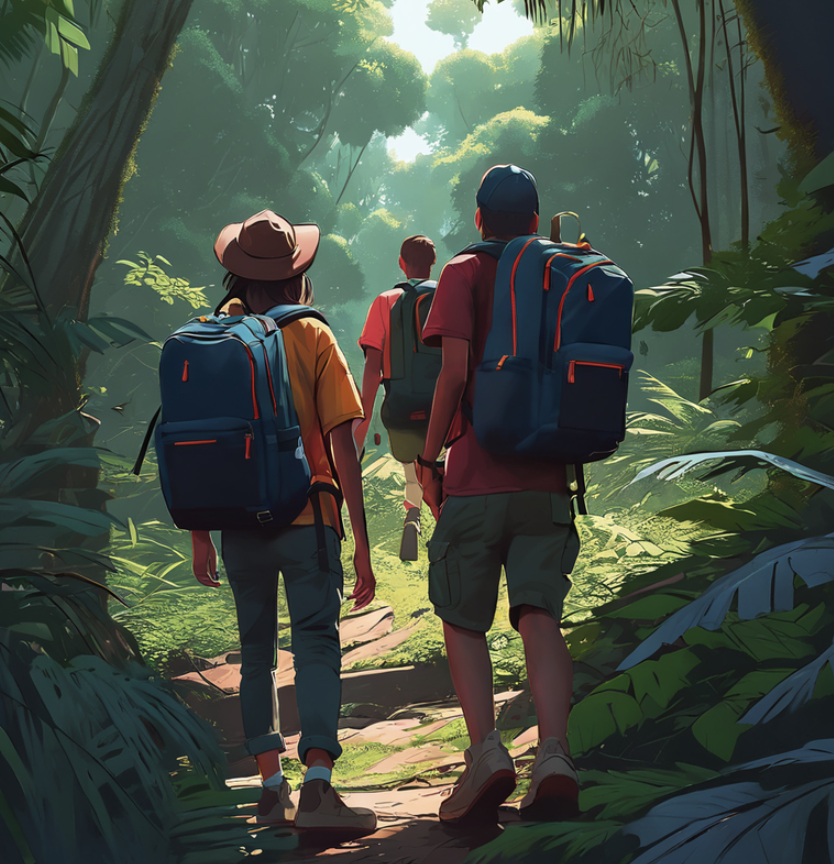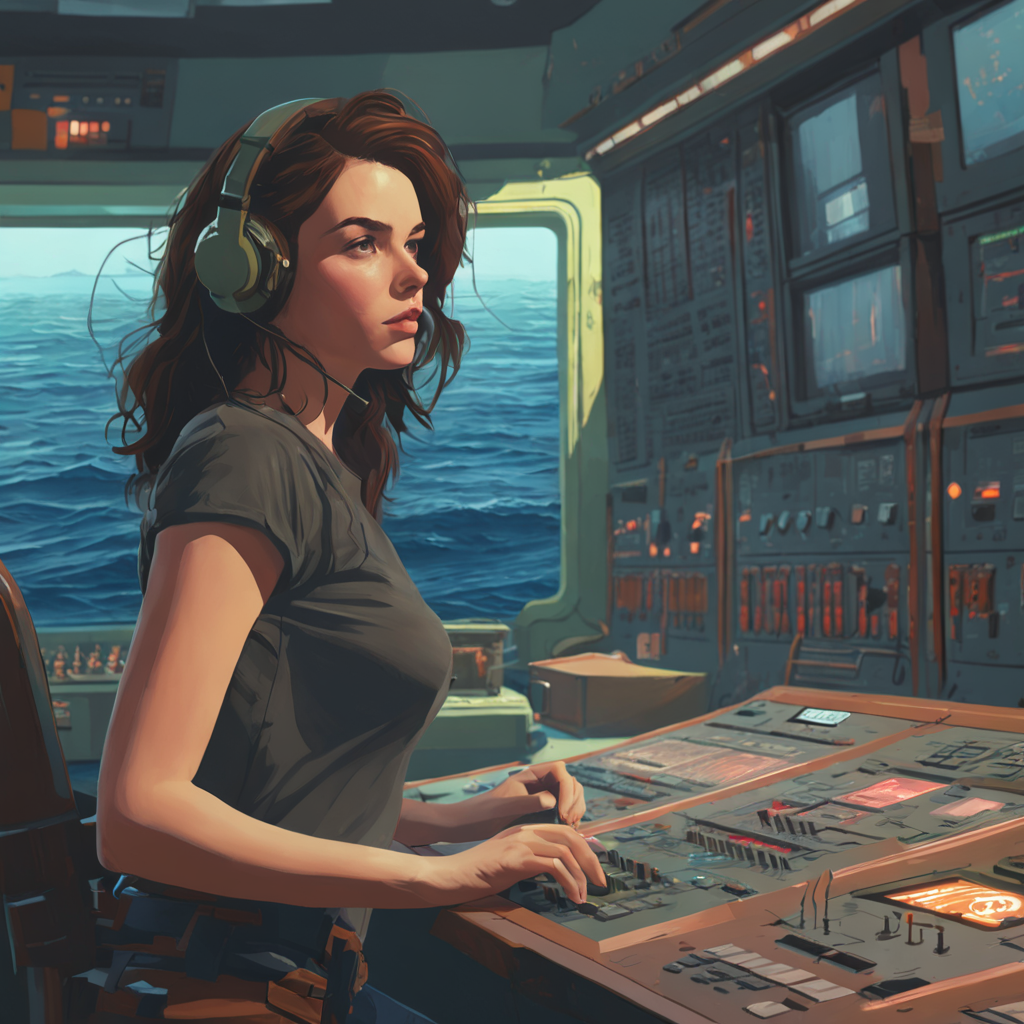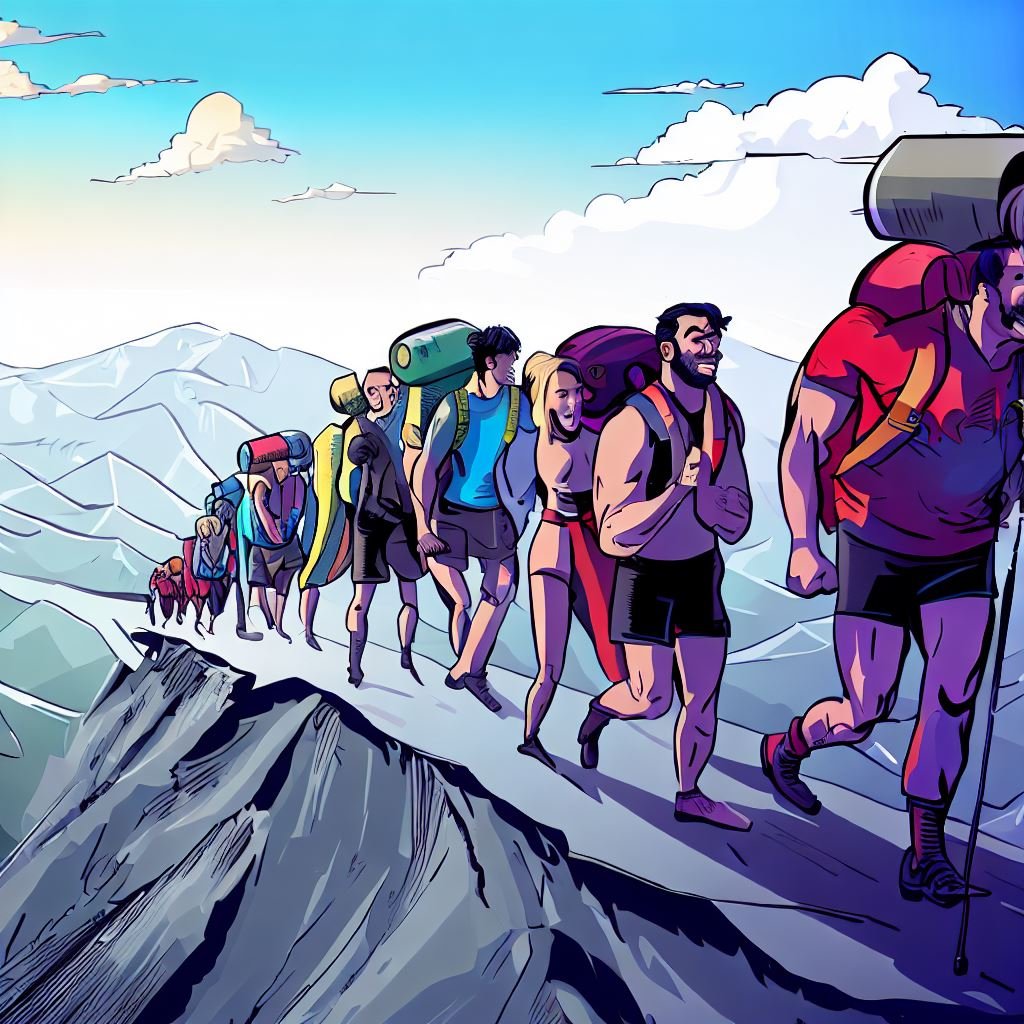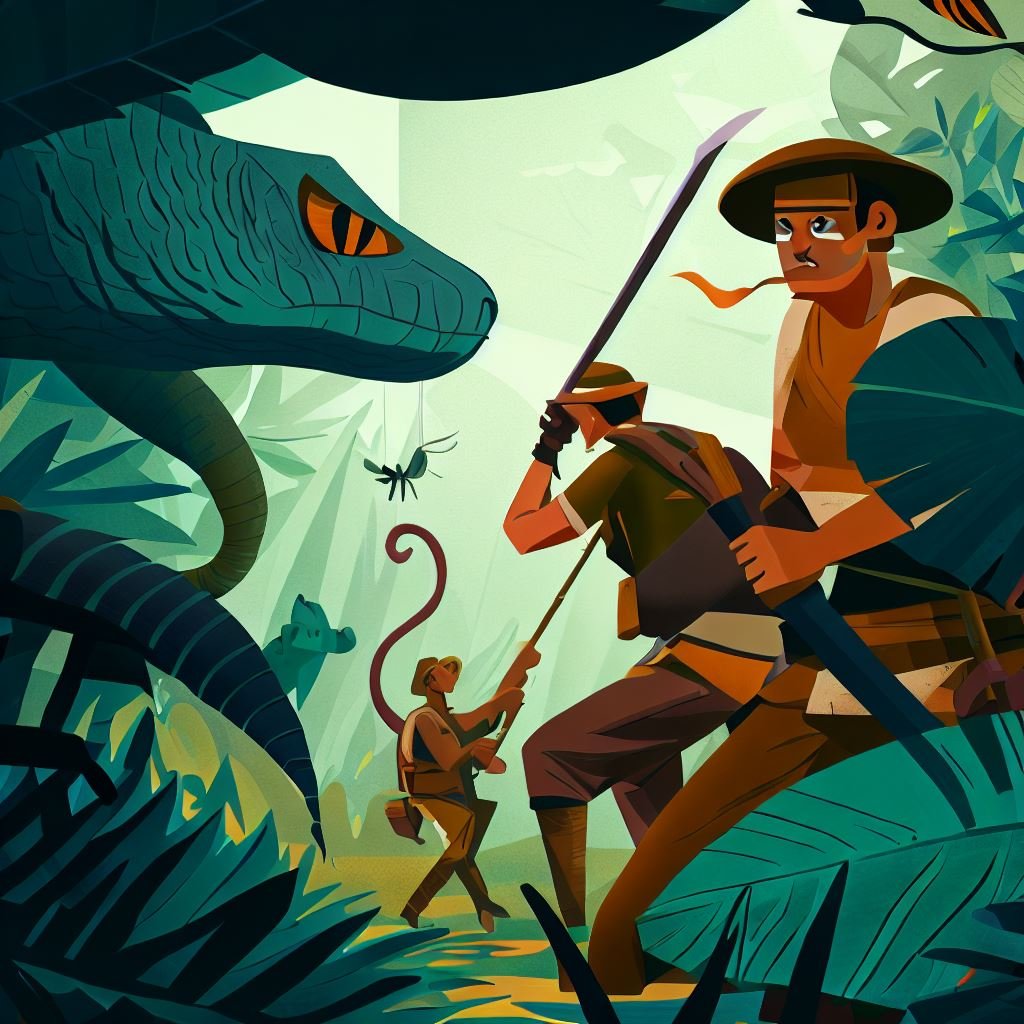This project was the recipient of the Teaching Excellence and Innovation Award at the D’Amore-McKim School of Business at Northeastern University (NEU), Boston campus, in the capstone course 4504 “Integrated Studies - Corporate Innovation” taught by Prof. Loredana Padurean.
Abstract: This paper discusses the experience of integrating various Artificial Intelligence (AI) tools in a fall semester experimental class project that took place from September to October 2023 at the D’Amore-McKim School of Business at Northeastern University (NEU), Boston campus, in the capstone course 4504 “Integrated Studies - Corporate Innovation” taught by Prof. Loredana Padurean. The 14 mostly senior students, in 4 teams, had to create a comic book based on an innovation lifecycle framework using any AI tools they found relevant. A task that wasn't so much about the creation of art itself, but the engagement of critical thinking to meticulously tailor AI-generated visuals that accurately embodied students comprehension and insights of the innovation lifecycle framework. Drawing from student sentiments (from a post project extensive survey) and faculty reflections, this paper highlights four important takeaways: (1) AI becomes less intimidating with experimentation, (2) when used properly AI accentuates critical thinking, (3) educators should intentionally and creatively bring AI into curriculum to reflect our new realities and (4) AI is as a collaborative partner, that can enhance group learning, encourage peer interaction, and make education more dynamic and enjoyable. Initially apprehensive, students eventually came to view AI as a tool that could elevate their academic performance and equip them with innovative means to address real-world problems, transcending conventional approaches. Critics rightly caution that unsupervised use of AI might undermine the development of critical thinking skills. But maybe surprisingly, these students are learning that AI doesn't offer shortcuts to critical thinking but rather invites them to dive deeper: to question, to refine, to search with purpose. To quote one of them, “We mastered the internet search, now we have to master the prompt”. Contrary to concerns of AI limiting collaboration, our findings indicate that with proper integration it can amplify peer interactions, fostering enthusiasm, participation, create excitement and fun, making learning more engaging and appealing to students thus leading to higher retention. "However, AI integration is not about shortcuts or compromising on the authenticity of academic work. Nor is not about a replacement for individual creativity and thought, but rather a potent partner for increased productivity redirecting valuable time to more analytical and inventive pursuits. This limited experiment concludes with a reflection, rather than a definitive conclusion. AI is not the master (yet!) but a sophisticated partner that scales with one's intellectual curiosity and capacity. And while it may initially intimidate, its consistent use demystifies its complexities and adds excitement to learning, reflecting the natural progression of our societal evolution, a new revolution that, like those before it, requires us to adapt and learn how to wield new tools.
DOWNLOAD THE COMPLETE PAPER HERE
This paper explores the integration of AI tools in a Northeastern University capstone course, where students created a narrative of innovation through images and captions in the form of comic books using AI to illustrate an innovation lifecycle framework.
Despite initial intimidation, experimentation with AI fostered engagement and enhanced critical thinking, "underscoring the importance of incorporating AI into education in a thoughtful manner" .
Findings suggest that AI, when used effectively, does not simplify critical thinking but enriches it, prompting students to engage with more depth and reflection.
The study concludes that AI, as a collaborative partner, can enhances learning, encourage peer interaction, and makes education more dynamic and enjoyable, leading to better retention and a more profound understanding of the subject matter.
*AI in the Classroom: From Intimidation to Innovation, PADUREAN ET AL, 2023, Nov 2023, BOSTON, USA
FINDINGS at a GLANCE:
AI demystifies with exposure, becoming less intimidating over time.
AI serves as a valuable partner in fostering critical thinking and open-ended exploration.
Properly integrated, AI can enhance rather than diminish collaboration among students.
Take aways at a glance:
AI-infused projects introduce an element of fun, boosting student engagement and creativity.
A shift is observed from memorization to application in learning methods.
Practical (experiential) learners benefit significantly from interactive AI-aided lessons.
AI's real-world relevance deepens student engagement and understanding.
Educators face new challenges in assessment due to AI's capabilities.
Instant feedback from AI tools promotes active student participation.
AI fosters innovative problem-solving and enriches students' analytical skills.
INTRODUCTION
In the fall of 2023, I began teaching a corporate innovation capstone course for the undergraduate business school students at Northeastern University's D’Amore McKim School of Business in Boston. At high level, the course explores various models and lifecycles of corporate innovation across companies and industries.
As I was preparing for the course in the summer of 2023, there was an evident interest in AI in the academic circles. And if I were to teach about the latest developments in corporate innovation, AI had to be part of the narrative. However, the question I had was how to integrate AI in a way that felt organic and purposeful to the course.
While I don’t possess a deep technical background, I have consulting experience in digital and organizational transformation. Through conversations with experts, particularly with my former student, Commander Himanshu Joshi of MIT Sloan, and attending insightful workshops, such as one by Google in New York, I deepened my understanding of AI.
This experience made me think: How could I integrate the latest AI thinking models into a course about corporate innovation? More importantly, could I credibly teach about corporate innovation without addressing AI, arguably the most disruptive innovation of the decade?
So, by September 2023, 14 eager students, the proud and well deserving co-authors of this paper, embarked on the INNO4504 course journey. Though AI wasn't initially central to the syllabus, its relevance grew apparent. The course was divided into two key parts and areas: the introduction to “Nail it, Scale it, Sail it (NSS)” framework, which I co-developed with Prof. Charles Fine from MIT Sloan, and an exploration of corporate innovation models using HBR case studies (post AI project).
A unique aspect of the course was a group project where students, using AI tools, would create a comic book capturing the essence of the NSS innovation lifecycle framework. This framework highlights how innovation strategies shift from startups, characterized by agility and rapid pivoting, to scaling companies that adopt more structured approaches, and finally to established corporations that often have to navigate bureaucratic challenges. Using the metaphor of a journey, I likened startups to navigating a dense jungle, scaling companies to mountain hikes, and large corporations to steering vast oceanic tankers.
METHODOLOGY
The approach adopted for this short project was multi-faceted:
1. Framework Introduction: Over six sessions, students were deeply immersed in the “Nail it, Scale it, Sail it” innovation framework, ensuring they grasped its nuances and applications.
2. Expert Interaction: I invited Commander Joshi Himanshu from the Vector Institute of Applied AI in Ontario, Canada to share his expertise on AI. He provided invaluable insights, as reflected by student feedback: "Having someone with a high level of expertise speak to us before the end of this project was extremely helpful."
3. Real-world Application: To bridge theory and practice, I invited entrepreneur Mark McGarry from Boston to showcase how the framework had real-world applications, further grounding students' understanding.
4. Company Visit: Together we went an on-site visit to "Ministry of Supply", a Boston-based fashion tech company prominently featured within the framework. This hands-on experience provided students with a tangible sense of the framework's practical significance.
5. Feedback Loop: After the course's conclusion and project submission, I surveyed the on their experiences and perceptions at different stages - before, during, and after the project - to refine future iterations.
This paper captures their answers and reflections. All the quotes come from the students. All images were created by the students using imagine.ART
PROJECT RECEPTION
Eagerness and Excitement
- "I always prefer projects over papers and exams..."
- "I was very excited as this project would involve using AI tools that I hadn't experienced before..."
Concerns:
- "The perceived complexity of AI made me apprehensive."
- "I don't see myself as particularly creative, so that added another layer of concern."
- "The project's demand for creativity and out-of-the-box thinking was initially daunting."
Overwhelmed and Apprehension
- "Art isn’t my strong suit, so this felt daunting. "
- "Learning about the comic book project initially made me feel overwhelmed and nervous."
- “Given my limited knowledge on the topic, the project seemed intimidating.”
Skepticism and Doubt
- "Using AI seemed to simplify things too much, making the project feel somewhat trivial.”
- "While I started off excited, I wasn’t sure of its potential success."
Appreciation for Exploration
- "This project pushes us to devle deep into the AI ecosystem, especially since Ai art plays such a vital role. As budding entrepreneurs, mastering something from scratch aligns with our journey. "
- "Telling a story, rather than a standard framework analysis, felt refreshing.”
Uncertainty
- "I struggled with how best to tackle the project tactically."
- "The uncertainty of which AI tools to employ and their optimal use was a bit disconcerting."
- "Starting the project felt like a challenge, given that I didn't have a clear starting point."
The diversity of reactions underscored a vital lesson: Introducing novel tools like AI in pedagogy means I must validate students' enthusiasm while simultaneously addressing and empathizing with their concerns.
PREVIOUS EXPERTISE WITH AI
From my end, I had a foundational grasp of AI. My basic experience was centered around tools like Chat GPT, Google Bard, Bing Images, and Adobe Firefly. My students, on the other hand, generally perceived themselves as beginners, predominantly using ChatGPT, mostly for school assignments, market research, financial analysis, and coding email automation apps.
“I have not previously incorporated AI into my school assignments, this was my first time."
"No - I had never been asked to incorporate AI into any of my school assignments before this."
"I have never been assigned to use AI in a school assignment, but I occasionally use an AI tool to improve the grammar in my writing."
"I have incorporated my notes into AI to generate clear outlines..."
"I had used AI to help create outlines and give me brief summaries in previous school assignments..."
A few students had more confidence and practice:
"Yes, almost all the assignments nowadays."
"I would say I'm an intermediate user now... most professors want us to avoid it saying that the student's work should reflect their own knowledge."
But a couple of them have been exposed professionally in their co-ops (internships):
"In my previous co-op my boss used it to create policies..."
"In my 2nd co-op I worked on an AI enabled medtech device (the year before ChatGPT)..."
Such a varied spectrum of prior knowledge underscores the diversity of the student body in terms of AI exposure and application and honestly, made me realize that we are still in the early nailing days of using AI in both professional and academic settings.
CRITICAL THINKING and AI
Many critics of AI in the classroom stress the valid concern that using AI without direction or planning, will negatively impact our students critical thinking abilities. If critical thinking is simply the ability to not accept all arguments and conclusions but rather question them, how can AI help our students avoid this trap?
- "I found that I am learning to speak to a new system ."
- " Critical thinking is abut diversity in thoughts and using AI gave me more perspectives and answers and I had to use my judgement to choose the right ones. "
-” Using AI tools saves me a lot of low value time that now I can use for more critical and creative work”
-”AI grows with you and your abilities, the more intelligent you are the more supportive it is. And is only as limited as you are”
-”AI is a natural extension of our society. The same way we had the Agricultural or Industrial Revolutions, now we have the AI revolution”
-”Don’t take anything at face value! Challenge the first responses, change your prompts. Keep looking!”
-”You really have to know what you are looking for and keep trying until you find it”
Critics rightly caution that unsupervised use of AI might undermine the development of critical thinking skills.
Yet, as our students' reflections suggest, AI can become a catalyst for fostering a critical mindset if utilized strategically. As they engage with AI, students are not only learning a new language but are also being presented with a multitude of perspectives, challenging them to sift through varied responses and discern the most valid. The intelligent use of AI can streamline routine tasks, redirecting precious time to more analytical and inventive pursuits.
Students are learning that AI doesn't offer shortcuts to critical thinking but rather invites them to dive deeper: to question, to refine, to search with purpose.
A COLLABORATIVE APPROACH
Though Commander Joshi’s lecture provided some foundation, I was, in essence, navigating uncharted waters in this project. However, the beauty of humility is that when you seek help, it often appears. A pivotal moment came when my students Siyuan Zhang and Luis Sebastian Salcedo (both AI enthusiasts) led the quest for the right AI tool. Following various trials with Bing Images and Adobe Firefly, they endorsed Imagine ART as our go-to tool.
Their peers expressed gratitude for the direction:
- "I found that Sebastian and Siyuan's direction initially given their AI experience to be helpful."
-”Prof. Loredana told us that this is not a classroom but this is a community where we all learn together and from each other! I could see us building this community every day! “
For this venture, I leaned on the design thinking methodology, urging students to ideate, test, prototype, and introspect. This sentiment resonated with the students, as they shared:
- "Having time to experiment with different AI tools, learn about helpful image generation sites, and bouncing off tips."
- "I found it useful going over how to use Imagine.art with the class and trying it out..."
- "The professor explicitly introduced several powerful AI-generated techniques to us... to just play around with the AI at the start... Also, hearing from the more knowledgeable/experienced students on what works and what things mean."
- "I experimented with different prompts and used different seeds. I played with ordering of words, different seeds, and even different art styles."
- "And talk to GPT, since AI understands AI better."
Design thinking it’s an important method used in our department, as it emphasis autonomy, creativity, and collective learning:
- "I found it helpful that the professor gave us liberty to approach the project as we wanted. This relieved the worry of getting something I didn't necessarily want to produce but incentivized me to explore more options and be able to take bigger risks."
- "I loved the demo and the brainstorming roundtable we held, where we saw all types of useful platforms and most importantly, how to use them."
The overarching sentiment was clear: the students valued the project's dynamic structure, which interwove structured guidance with vast creative freedom.
This approach not only facilitated skill acquisition but also inspired innovative problem-solving especially through peer-led learning, highlighting the essence of collaborative education. The autonomy granted to students catalyzed creativity and daring, enriching their engagement level.
In essence, the learning design emphasized the intersection of where structured guidance meets independent exploration, all within a supportive learning community.
THE ROLE OF THE FACULTY
After spending most of my summer exploring the AI frontier, I still considered myself a novice, but I was very confident in sharing with my students both my enthusiasm, my limitations, and my guidelines.
Following the conclusion of the project, I asked my students to share what they found useful and what can others learn from our process:
Attitude and energy
“From the very beginning to the end, the professor has consistently expressed her excitement and encouragement to see our final outcomes. Her optimistic perspective on AI has greatly boosted my confidence in its use.” “The professor was optimistic AI, so were we. She also brought a speaker that helped us understand the whole concept of AI and the opportunities it gives. Instead of being averse to the idea, it gave us excitement to explore this field more.” "The professor’s openness and honesty about her curiosity and interest in this growing technology was refreshing, when many other professors are unwilling to interact with newer technology, and thus spend the time required to regulate it.”
Build a collective learning community:
"The exploratory perspective made it easy to want to try it ourselves. Also, Loredana invited everyone to share their own takes and really made it a class dialogue, so we all heard a multitude of takes/concerns/excitements/etc. around the topic. We really became a community!”
Respect for experimentation:
"The Professor encouraged us to experiment and revise and gave us time to figure out how it works on our own. I think that greatly enhanced the learning experience and allowed me to take a lot more out of the project.” "Her desire to have the class learn from each other and experiment with us made the entire experience an enjoyable process.”
Build a strong motivation:
"It was very nice to have this project because if you don't learn how to manage and use AI, there is always gonna be someone who does; and this person will outpace you in the workplace. After all, only survive those who can adapt to change.”
BUILDING THE AI TOOLKIT
Our mission seemed straightforward: create a narrative of innovation through images and captions. However, despite utilizing the premium version of Imagine.art, translating thought into visual proved more challenging than anticipated.
It became clear that while AI has come far, it hasn't mastered mind-reading.
Students expressed frustrations about the precision of image outputs:
- "Finding the image that portrays exactly what we want for our video was extremely difficult. It took some time figuring out how to communicate with the image-generating AI."
- "I had trouble communicating with the AI in Imagine.art to get what I wanted, and so it took many tries to get one image."
- "I struggled to get the AI to produce specific images. It had difficulty creating groups of people, and often there were unwanted details."
- "Characters: if the description of a person was not the only feature or main item in a prompt, their face would often be distorted upon closer inspection."
The inconsistencies between prompts and outcomes posed significant hurdles:
- "We identified inconsistencies between the prompts and outcomes, making it even more challenging when we attempted to 'fix' the prompts."
- "Generating consistent results and characters with unique characteristics was tough."
A lack of originality and repetition became apparent over time:
- "Originality: after using the same model + seed for a while, many of the images it produced started to look mostly the same with slight variations, even if the prompt was entirely different."
Surprisingly, efficiency became an issue:
- "The primary challenge I faced when using Imagine.art was the disparity between the image I envisioned in my mind and how the tool interpreted my prompt. I also struggled with the tool's slow image generation speed..."
- "Even though it was much faster than producing them manually, it only gave 1 image per submission, making it tedious to produce various versions of an image."
The scope of the project developed beyond my initial belief as the students were able to unite their intellectual capabilities with the wide project parameters. They used Imagine.art and Bing for image generation, ChatGPT for script generation, and then utilized their newfound AI knowledge to create prompts for image generation using ChatGPT. They found that one AI can very effectively communicate with other AI applications, showing one application of their critical thinking in this project.
This exploration phase highlighted the importance of familiarizing oneself with a tool's capabilities and limitations.
“It’s critical to note the current state of AI tools. While they offer transformative potential,
they are not without challenges.
The struggle to communicate precise requirements, manage inconsistencies, and the tools’ occasional inefficiencies emphasize that AI, while powerful, remains a tool that requires adept handling and iterative refinement.
The journey also highlights the students’ resilience and adaptability in navigating these challenges to harness the potential of AI.”
Prompt Engineering* is the name of the GAME!
One of the highlights from Himanshu’s talk was the need to develop a new skill called “prompt engineering” (see more on next page).
To draw an analogy, consider prompt engineering as the equivalent of refining a search query on a search engine. The more precise and thoughtful your search terms, the closer the results align with your expectations. With AI, especially powerful language models, this principle is magnified.
Crafting your prompt isn't just about asking a question or making a statement; it's about providing a clear, focused direction to guide the model toward the desired output.
(Note: WHAT IS PROMPT ENGINEERING? *Prompt engineering is a technique used primarily in the context of language models and other machine learning models, where the goal is to craft specific inputs (or "prompts") to elicit desired outputs from the model. This technique has become more relevant with the advent of powerful models like GPT-3 and GPT-4, which can generate diverse outputs based on the prompts they receive. Prompt engineering involves understanding the behavior and tendencies of a model and designing prompts that guide the model to produce outputs that are accurate, relevant, or adhere to specific guidelines. It can be both an art and a science, as it often requires iterative experimentation to refine prompts to get the desired results.
In many applications, prompt engineering can serve as a way to:
Reduce biases in the model's responses.
Enhance the model's focus on certain topics or perspectives.
Elicit more detailed or specific information.
Guide the model to follow certain stylistic guidelines or tones.
For instance, instead of asking a language model, "Tell me about Paris," which is a broad query, prompt engineering might involve asking, "Can you provide a concise history of Paris during the Renaissance?" to guide the model towards a specific kind of response.
While powerful, prompt engineering has its limitations, and it doesn't always guarantee that the model will consistently produce the desired outputs. But with careful crafting and understanding of the model's behavior, it can be a valuable tool for harnessing the capabilities of advanced language models in more controlled and targeted ways.
So, what makes prompt engineering pivotal?
1. Precision: As with our Imagine.art efforts, the clearer and more specific the instruction, the closer the output aligns with expectations. Ambiguity can lead to results that, while technically accurate, might not align with the user's vision.
2. Bias Minimization: AI models can sometimes replicate or magnify societal biases present in their training data. Through effective prompt engineering, one can steer the model away from potentially biased or controversial outputs.
3. Tailored Outputs: Whether you desire a formal tone, a specific style, or a unique perspective, refining your prompt helps shape the model's response in line with your preferences.
4. Efficiency: Reducing back-and-forth iterations saves time. A well-engineered prompt might yield the desired result in one attempt rather than multiple trials.
5. Exploiting Full Potential: Advanced models like GPT-3 and GPT-4 have immense capabilities. Prompt engineering ensures that users can tap into these capabilities effectively.
In my personal and brief journey with AI, prompt engineering emerged as a cornerstone skill. For novices, understanding this technique is akin to unlocking a powerful spell in a video game. And as with any skill, mastery comes with practice and reflection.
Each interaction with the model becomes a learning experience, teaching the user more about the model's nuances and tendencies. Over time, this iterative process of prompt adjustment and outcome assessment sharpens one's ability to communicate with the model effectively.
“We mastered the internet search.
Now we have master the prompt.”
My students highlighted 5 important and more specific needs:
Brevity and Clarity:
- "Simpler prompts are better." - "I found the order of the words was very important and it was better to give short, clear words as prompts rather than descriptive sentences."
Importance of Word Order:
- "The order of sentences matters a lot." - "Importance of word order, conciseness, not too general, but not too specific." - "Changing just a few words, or even the order of the words was extremely helpful."
Balancing Specificity and Generality:
- "Prompt generation continues to confuse me, but I've learned that clear and concise prompts with simple details lead to more accurate photos."
Exploration and Adaptability:
- "Iteration is key. Instead of scrapping an entire prompt when you don't get the desired outcome, changing just a few words... was extremely helpful." - "Initially I tried AI art myself but only on one app, it was clumsy and stupid. This project pushed me to explore all the viable options and I found out it was my methodology was wrong." - "I realized that prompting is much more specific than I had previously thought, and that my previous method of prompting AI was inefficient."
Formulaic Prompt Approaches:
- "We learned that direct questions composed of a word, or series of words surrounded by commas worked best." - "My team found it helpful asking ChatGPT to help us generate prompts for Imagine.art."
In this dialogue between man and machine, prompt engineering is the language of clarity, precision, and intentionality. And as with any language, fluency comes with practice, patience, and persistence.
Ultimately, while AI models are groundbreaking, their effectiveness depends on the user's ability to communicate intent.
We strongly believe that at the end of the day, any of these AI tools mirror our own capabilities and limitations.
Ask a stupid question (yes, there is such a thing as a stupid question) and the answer might not be too much smarter!
Assessing Quality: A Multi-Faceted Approach
So, what makes prompt engineering pivotal?
1.Alignment with Vision: An image's worth is initially gauged by how closely it mirrors the initial vision. This encapsulates both the image's aesthetic and its underlying narrative.
-"If the image clearly and succinctly matched our vision and prompt and conveyed the emotional and physical characteristics of our idea."
2. Consistency: In projects with multiple images, maintaining a thematic uniformity becomes vital. It ensures a coherent and immersive viewer experience.
-"We found one image we really liked at the start, and used that as the base theme for the others."
3. Conveyance of Message: The prime purpose of any image is storytelling. Its capacity to relay the intended message without distractions determines its value.
-"We dwelled many days on what seed and style we would use. Once we decided as a group which combination we are using, all the images the AI produced had the consistent quality we looked for."
4. Quality and Realism: While the fantastical outputs of AI can be enticing, it's the realistic, distraction-free images that often hold more merit, especially in serious projects.
-"Degree of realism - were there any crazy distractions / hallucinations in the image that would subvert the intended message."
5. Adaptability: Often, the perfect image on paper might not fit within the broader narrative. The flexibility to accommodate images that align with the larger storyline, even if they aren't the original vision, is a pragmatic approach.
-"Because we knew the editing part would probably require extra time, we quit trying to find images with the exact design."
Navigating the AI tools, especially in the realms of image generation, is a journey of discovery.
It involves a deep understanding of the tools, a continuous feedback loop, and a blend of artistic judgment and practical considerations.
The insights from the students reflect not just their struggles and learnings but also the evolving nature of human-AI collaboration in creative endeavors.
Facing AI Fears: Be afraid! Be very afraid?!?
While writing this paper in a local coffee shop, I struck up a conversation with two art professors from Emerson College. They mentioned their ongoing research on women directors and their challenges in sourcing diverse respondents. Suggesting the use of ChatGPT, I was met with instant apprehension, "I am afraid of AI! And I wouldn’t even know how to start!"
Do this sentiment sound familiar? Both my students and I echoed similar feelings at the start of our AI project. However, the journey that unfolded drastically altered these initial perceptions.
1. Overcoming AI Apprehensions: For a considerable segment of my students, their initial trepidation towards AI faded as the project advanced:
- "It has brought my reservation of AI down to near zero."
- "I learned not to fear AI but to improve my communication with it in order to achieve my desired results."
- "My perspective on AI became more optimistic when I realized there are numerous ways AI could assist me, including image and video generation. Now, I am excited and confident to integrate it further."
Conversely, some students found their apprehensions intensifying in certain respects:
- "It diminished my concerns of AI replacing jobs, but enhanced concerns about how rapid it is developing and the privacy concerns that come with that."
2. Demystifying AI’s Capacities and Limits:
An enlightening revelation was the recognition of AI's current limitations:
- "Now I know there is an AI for virtually everything - I used to think AI was limitless, but now I know that currently that is not the case."
- "This project diminished my concerns about the idea of AI being smart enough to "replace" us, as it is quite far away from that level, and lacks the ability to reason."
The mysteries of AI were unraveled for many:
- "It stripped most of the magic away. I understand (in practice, not in coding) stable-diffusion algorithms, generative AI algorithms, and where they have biases and weaknesses now."
A sentiment that struck a chord was the realization:
- "I understand that AI isn't a threat to me, it's humans that use AI."
The project brought to the forefront a transformative journey from fear to familiarity, from uncertainty to empowerment. The revelations weren't merely about AI's capabilities but, more significantly, about the harmonious confluence of human creativity with machine intelligence. For many, the experience wasn't just about mastering a tool but about self-realization and expanded horizons. The journey was less about AI as a potential threat and more about understanding it as a collaborator, a tool to enhance human potential. The overarching lesson?
Image developed by the students with imagine.ART
While AI is powerful, it is, at the end of the day, a tool — and like all tools, its impact is shaped by those who wield it.
If you’re happy and you know it!!!
Following an intensive period of hard work and experimentation with AI, the consensus among my students is overwhelmingly positive. They found the outcomes not only meeting but often surpassing their expectations, achieving a level they equate to professional standards. Many expressed astonishment at the caliber of the results, highlighting the project's ability to combine diverse interpretations of a singular topic.
"I think it is really remarkable what we did!"
"Beyond my expectations—I did not imagine that they would turn out as good as they did."
"I was very happy with our tangible product."
"Viewing the final product was very insightful. It reflected the combination of four different teams and their interpretations of one topic.”
"The focus is not about technical knowledge, but about pushing ourselves out of status quo and explore the fullest potential of AI."
"It really reveals how wildly different the AI can work and also how wildly different we as individuals think/understand what's presented to us."
The exercise underscored the essence of transcending mere technical knowledge. Instead, it was an invitation to challenge the norm, exploring the vast potential of AI and understanding its diverse applications based on individual perspectives.
RE-LEARNING HOW TO LEARN
The continuous evolution of technology has always influenced the paradigms of education. Recently, the integration of Artificial Intelligence into academic exercises offers a fresh perspective on learning. But what does this mean for traditional academia, which has historically been centered around textbooks, lectures, and paper-based assignments? To gain deeper insights, I asked my students to compare their experiences with conventional academic tasks.
1.Navigating the Steep Learning Slopes of AI:
The AI project introduced an unfamiliar territory for most:
"The project felt like working out a new muscle, contrasting the monotonous feel of traditional assignments."
"The ultimate goal of education is lifelong learning. With AI, you can explore myriad fields, surpassing the confines of conventional education."
2. The Intricacies of AI Engagement:
Effective interaction with AI demanded iterative brainstorming and experimentation:
"AI required continuous brainstorming, especially in crafting the perfect prompt."
"Generating images with AI demanded clarity in vision and precision in articulation."
3. Intensified Effort and Duration:
The AI venture demanded unparalleled dedication:
"Unlike routine assignments, this demanded days of rigorous engagement."
"Rather than mere information retrieval, this demanded envisioning, articulating, and iterating."
4. A Fusion of Creativity and Analytical Thinking:
This AI exercise broke the confines of rote learning:
"It engaged both critical and creative faculties, urging me to think unconventionally."
"I ventured into realms like composition and perspective, which otherwise remained unexplored."
5. A Gratifying Learning Experience:
Despite the challenges, the outcome was highly rewarding:
"The uncertainty of outcomes was overshadowed by the satisfaction of acquiring a new skill and exploring a nascent industry."
"This journey with AI made me feel future-ready and instilled a sense of responsibility."
6. A Fresh Academic Endeavour:
Compared to familiar academic exercises, the AI project stood distinct:
"The project was more demanding, urging a shift from traditional thought processes."
"The AI approach demanded patience, risk-taking, and a clear directional vision."
We must admit that the introduction of AI into the academic space undeniably presents a radical shift from traditional educational methods. It's not merely about replacing old methods but augmenting learning outcomes.
This AI project was not just another assignment; it was an exercise in adaptability, continuous learning, and embracing future technologies. It challenged students to push boundaries, think critically, and immerse themselves in the ever-evolving realm of AI.
While traditional methods have their extraordinary merits, the integration of AI in education offers a dynamic, hands-on, and forward-thinking approach, preparing students for a rapidly changing world.
AI Integration: A Contemporary Necessity in Education (?)
In this digital age, AI is taking center stage in revolutionizing multiple sectors. The academic realm is no exception, and the call for integrating AI into the educational framework grows louder, especially among proactive institutions and students.
1. Elevating the Academic Bar:
AI's prowess isn't just in data processing but in its potential to reshape educational objectives.
"As AI permeates various industries, there's an urgency to elevate our academic standards, ensuring our tasks are as robust as real-world applications."
"The future demands not just awareness but expertise in AI implications across varied professions."
2. AI: An Ally in Decision-making:
The expediency AI offers in decision-making, especially in business, emphasizes its centrality.
"A time-sensitive business environment will inevitably lean on AI's swift analytical capabilities to drive decisions."
"While AI can swiftly process multitudes of options, it's up to human minds to cultivate discernment – a skill that remains irreplaceable."
3. A Competitive Edge:
In the job market, AI proficiency isn't just a skill – it's an advantage.
"The employment landscape will inevitably favor those adept in AI, as they bring efficiency and innovation to the table."
"Harnessing AI tools in day-to-day tasks is no longer a choice but an impending necessity."
4. Harnessing AI: Enhancement not Exploitation:
The objective is to make AI an ally in learning without it becoming a crutch.
"There's a thin line between AI as a facilitator and a replacement. Our goal should be to tread that line responsibly."
"The academic realm should prioritize teaching students the distinction between AI as an augmentation vs. AI as a substitute."
5. AI: A Supplement, Not a Surrogate:
AI is poised to amplify our capabilities but not to overshadow our inherent human qualities.
"We must remember that AI's role is to complement, not to consume, our academic journey."
"Embracing AI doesn't mean relinquishing our individuality or creativity."
6. AI's Role: Pervasive, but not Universal:
The clamor for AI integration should be met with discernment, ensuring its applicability is context-driven.
"AI's inclusion should be strategic, tailored to courses where its relevance is undeniable."
"Every academic tool, no matter how advanced, should be applied with prudence."
Northeastern University, like many forward-thinking institutions, faces a critical juncture in deciding the extent of AI's integration into its curriculum. While the overwhelming sentiment underscores AI's inevitable relevance, it's pivotal to approach its incorporation with caution, ensuring that it enriches the learning process rather than dilutes it.
It's not about simply adding AI to the curriculum but about weaving it into the educational tapestry in a way that enhances learning, promotes critical thinking, and prepares students for a future where technology is inextricably interwoven with every facet of life.
Experimentation in AI: Charting Uncharted Territories
The landscape of AI, vast and ever-evolving, remains an enigma for many, its true potential often unveiled only through relentless probing. The reflections of the students on their AI image development project stand testimony to this sentiment.
Experimentation: The Cornerstone:
In an academic space dominated by defined guidelines and predetermined pathways, the AI realm is refreshingly nebulous, demanding adaptive exploration. "Unlike traditional subjects, AI doesn't have a set playbook. Success here hinges on the courage to tread unknown paths and innovate on the go." "Where textbooks fall short, experimentation bridges the gap, illuminating the intricacies of AI's behaviors and responses."
A Method to the Madness:
Far from haphazard attempts, this experimentation was structured, iterative, and feedback-driven. "Every trial was a lesson, a step closer to understanding the subtleties of AI communication. Our experiments were less about randomness and more about incremental learning." "Like adjusting dials to fine-tune a radio, each attempt helped us calibrate our interactions with the AI."
Embracing Volume for Precision:
Quantity paved the way for quality. To distill the essence of perfection, an overwhelming volume of output was a prerequisite. "From the vast sea of generated images, only a handful met our benchmarks. But without the sea, those gems would remain undiscovered." "Each redundant image was a clue, guiding our next attempt, ensuring we inched closer to our envisioned goal."
Acceptance of Imperfections:
AI, as powerful as it is, isn't omnipotent. Recognizing its boundaries and constraints is as critical as understanding its strengths. "There's a threshold to AI's capabilities. Sometimes, our visions surpassed what the AI could manifest. Acceptance of these limitations was a lesson in humility and adaptability." "The occasional brick walls we hit with the AI were reminders that technology, however advanced, has its bounds."
Tools: A Spectrum of Possibilities:
The AI toolkit is diverse, and often, the key to success lies in leveraging this diversity to one's advantage. "Being fixated on one platform could have been our downfall. Our adaptability, our willingness to venture beyond familiar tools was instrumental in our project's success."
In summary, the AI project served as a microcosm of the larger narrative surrounding technological innovation.
Beyond the nuts and bolts of image generation, it was a lesson in perseverance, adaptability, and the audacity to challenge the status quo. In the words of the students, it felt akin to pioneering a startup – an uncharted expedition where the only compass was experimentation.
And through this journey, the overarching message was clear: In the realm of AI, to innovate is to experiment.
Reflections from the Connection of Education and AI
We stand at a juncture where technology isn't just an adjunct tool in education, but rather an intertwined element defining its evolution. As AI threads its way into academic pursuits, it's vital to step back and reflect, not on conclusions, but on observations, experiences, and implications.
1. Demystifying AI Through Exposure: Indeed, unfamiliarity breeds apprehension. As educators and learners, our early brushes with AI might be fraught with hesitations and preconceived notions. Yet, with each interaction, this veneer of intimidation diminishes. The “A-Ha” moments surface when we realize AI isn't a replacement but a symbiotic partner, amplifying our critical thinking faculties.
2. AI's Role in Elevating Critical Thinking: Far from being confined to rote tasks, AI shines most brightly when it nudges us towards reflection, critical examination, and open-ended discussions. By integrating AI in projects, we're not just teaching students about technology; we're steering them towards exploration, discovery, and boundless curiosity.
3. Redefining Collaboration in the AI Era: One of the most intriguing revelations is how AI, rather than being an isolating force, fosters collaboration. Through well-orchestrated designs, AI can serve as a catalyst, enhancing peer interactions, stimulating discussions, and enriching academic experiences.
4. A Paradigm Shift in Learning: With AI, the classroom atmosphere undergoes a palpable transformation. The dreariness dissipates, replaced by an electric energy of curiosity, enthusiasm, and creativity. The traditional chalk-and-talk methods wane, giving way to interactive, dynamic learning experiences that resonate with all types of learners.
5. Transitioning from Rote to Real-world Application: AI brings a welcome departure from memorization-based approaches. Students are no longer passive but rather active participants, applying knowledge in innovative ways. However, this paradigm shift brings its own set of challenges, particularly around assessments.
As educators, it's our mandate to evolve our methods, ensuring not just knowledge uptake but its authentic application.
In essence, the intertwining of AI and education is not a mere trend; it's a transformative journey. As we navigate this evolving landscape, we're not racing towards conclusions; we're embracing continuous reflection, growth, and adaptation. The promise of AI in education is vast, and as stewards of this transformation, our reflections will shape its trajectory, ensuring it serves as an enhancer, not a detractor, of holistic education.
Suggestions for faculty members considering the incorporation of AI in their classrooms:
Embrace Experimentation:
Encourage a culture of trial and error. AI in education is still evolving, and there isn't a one-size-fits-all approach. Allow students the freedom to explore, iterate, and learn from their interactions with AI.
Integration Over Replacement:
Highlight AI as a tool to augment learning rather than replace traditional methods. It should be viewed as a complement that enhances understanding and skills, not as a complete substitute.
Focus on Critical Thinking:
Use AI to foster open-ended discussions and critical examinations. Given that AI can handle repetitive tasks, students can then focus on deeper, analytical challenges, boosting their critical thinking capacities.
Promote Collaboration:
Design AI-integrated projects in ways that encourage students to collaborate. When used effectively, AI can amplify peer interaction, mutual learning, and group problem-solving.
Training & Continuous Learning:
Stay updated with the latest advancements in AI. Consider attending workshops, webinars, or courses that offer training in AI tools relevant to education. This will ensure you're utilizing the technology to its fullest potential.
Ethical Considerations:
Introduce discussions about the ethical implications of AI, including data privacy, biases, and responsible AI usage. This will make students aware of the broader societal impacts and responsibilities tied to AI applications.
Shift from Memorization to Application:
Utilize AI tools to move beyond rote learning. With AI handling information retrieval, students can focus more on creative applications, synthesis, and real-world problem-solving.
Re-evaluate Assessment Methods:
With the integration of AI, traditional assessment methods might need revision. Develop new evaluation methods that account for AI's role while ensuring the authenticity of student work.
Highlight Real-world Relevance:
Connect AI projects and assignments to real-world scenarios. This not only makes learning more engaging but also prepares students for practical challenges in their future careers.
Hightlight collaboration:
Design AI-integrated projects in ways that encourage students to collaborate. When used effectively, AI can amplify peer interaction, mutual learning, and group problem-solving.
Seek Feedback:
Periodically gather feedback from students about their experiences with AI in the classroom. Their insights can offer valuable pointers for refining your teaching approach.
Be Enthusiastic while Patient and Adaptive:
Remember that both you and your students might face a learning curve when dealing with AI. Patience, perseverance, enthusiasm and adaptability will be crucial for a smooth and effective integration.
By embracing AI thoughtfully and judiciously in the classroom, faculty members can offer enriched learning experiences, preparing students for a future where AI will play an increasingly significant role across various domains.
FINAL CONCLUSIONS: ARTIFICIAL INTELLIGENCE IN MODERN EDUCATION: A REFLECTIVE EXPLORATION
In an era where technology is rapidly integrating into education, the impact of Artificial Intelligence on teaching and learning is profound and transformative. This paper explored the perceptions, experiences, and insights of students and faculty in a capstone course project in Innovation at D’Amore McKim School of Business at Northeastern University regarding AI's role in contemporary education.
The Case for AI in Curriculum:
Students overwhelmingly advocate for the integration of AI courses into Northeastern's core curriculum, emphasizing its increasing relevance in today's professional landscape. They believe it enhances academic standards, aids in decision-making, augments skill sets, and fosters critical thinking. However, there's also a cautionary perspective that while AI is impactful, it might not be universally essential for every discipline.
Experimentation and AI:
Experimentation emerges as a cornerstone in AI-driven projects. Students likened their experience to working in a startup environment, underscoring the significance of iterative trials, recognizing AI's limitations, and the necessity to pivot and adapt. They also highlighted the importance of using diverse AI tools to achieve project objectives.
Shifting Educational Paradigms with AI:
Beyond the technology itself, the paper emphasizes AI's transformative power in education. AI not only demystifies itself through exposure but also enhances critical skills, redefines collaboration, and catalyzes a shift from rote learning to real-world application. There's a higher student engagement, enthusiasm, and creativity in AI-infused classrooms. Nonetheless, this integration poses new challenges, particularly in assessments, urging educators to devise novel ways to ensure the authenticity of student work.
In conclusion, AI's intersection with education isn't just about technological integration; it's about reimagining learning paradigms.
This exploration is not a conclusive statement but a reflective journey, marking the beginnings of an educational transformation driven by AI.
Acknowledgements:
Prof. Loredana Padurean would like to acknowledge the extraordinary creative efforts of the NEU DMSB students in INNO 4504, and the “AI Commander” Himanshu Joshi for his guidance. This reflection is limited to a single classroom experiment and significant and further research is much needed. This paper was edited with the assistance of chatGPT4. Images were generated with imagineART. For copies of this report, please contact the primary author.
Contact: LOREDANA PADUREAN Associate Teaching Professor, Entrepreneurship and Innovation l.padurean@northeastern.edu
THE ENTREPRENEURSHIP AND INNOVATION GROUP D’AMORE-McKIM SCHOOL of BUSINESS, NORTHEASTERN UNIVERSITY, BOSTON,USA
Sample of the comic book images designed by the students with the assistance of imagine.ART













































